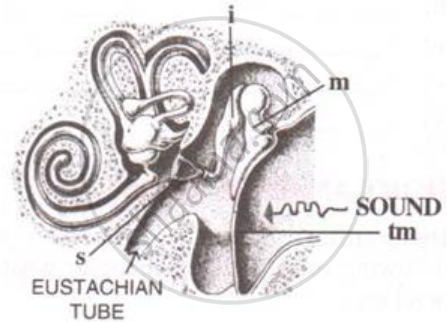Advertisements
Advertisements
प्रश्न
Complete the following sentence with appropriate Word
The sequence of ear ossicles of vertebrates starting from the tympanum is:
पर्याय
Incus, Malleus, Stapes
Stapes, Malleus, Incus
Malleus, Incus, Stapes
Stapes, Incus, Malleus
उत्तर
Malleus, Incus, Stapes
APPEARS IN
संबंधित प्रश्न
Draw labelled diagrams of the following: Ear
Write short notes on the following: Cochlea
Lightning and thunder take place in the sky at the same time and at the same distance from us. Lightning is seen earlier and thunder is heard later. Can you explain?
(i) Draw a well labelled diagram of the membranous labyrinth found in the inner ear.
(ii) Based on the diagram drawn above in (i) give a suitable term for each of the following descriptions :
1. The sensory cells that helps in hearing.
2. The part that is responsible for static balance of the body.
3. The membrane covered opening that connects the middle ear to the inner ear.
4. The fluid present in the middle chamber of cochlea.
5. The structure that maintains dynamic equilibrium of the body.
fill in the blanks with suitable functions: Ciliary body and __________.
Name the following:
The tube which connects the cavity of the middle ear with the throat.
Differentiate between members of the following pair with reference to what is asked in bracket.
Dynamic balance and static balance (Definition)
Mention if the following statement is true (T) or false (F) Give reason.
Malleus incus and stapes are collectively called the ear ossicles.
Name the three ear ossicles.
Name the three tiny bones present in the middle part of ear.
Give the main function of the following:
Cochlea
The figure below is the sectional view of a part of the skull showing a sense organ:

What are the parts labeled 'm', 'i' and 's'? What do these parts constitute collectively?
Differentiate between:
The middle ear and Inner ear.
Draw a labeled diagram of the inner ear. Name the part of the inner ear that is responsible for static balance in human beings.
Describe the structure and function of the human ear?
Assertion: Human beings Cannot hear infrasonic sounds.
Reason: Sound with a frequency less than 20 Hz is called infrasonic sound.
Categorise the following parts under (i) external, (ii) middle and (iii) internal ear.
Ear drum, hammer, pinna, cochlea, anvil, stirrup, eustachian tube, tympanum, oval window, semi-circular canals.
Given below is a diagrammatic representation of a part of the human ear.
- Name the parts numbered 1-6.
- Which parts of the ear shown here are complete.
 |
With reference to human ear answer the question that follow:
Name the part of the ear associated with the amplification of vibrations.
